THIS May we are once again celebrating the genius that is C.B. Mayshark! Mayshark took over the covers duties on Flying Aces from Paul Bissell with the December 1934 issue and would continue to provide covers for the next year and a half until the June 1936 issue. While Bissell’s covers were frequently depictions of great moments in combat aviation from the Great War, Mayshark’s covers were often depictions of future aviation battles and planes, like May 1936’s thrilling story behind its cover which imagines what an action test of the mighty Douglas bombers vs the new Northrop Fighters might look like!
Action Test of the Mighty Douglas
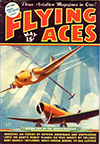 OUT of a brilliant blue haze, several streaking shapes suddenly appear. They are mid-winged, twin-motored, super-streamlined bombers. And as they come screaming down the airways, they give one an impression of darting, kill-mad hawks. Their objective is an important army field in the distance. At the critical moment, these bombers will release explosives—tons of explosives—and the field and everything on it will be blown to smitherines.
OUT of a brilliant blue haze, several streaking shapes suddenly appear. They are mid-winged, twin-motored, super-streamlined bombers. And as they come screaming down the airways, they give one an impression of darting, kill-mad hawks. Their objective is an important army field in the distance. At the critical moment, these bombers will release explosives—tons of explosives—and the field and everything on it will be blown to smitherines.
The bombing of the field is an order to be carried out—a purpose to be accomplished. The crews within the hurtling bombers close their eyes to slits, set their mouths in a firm line indicating grim determination. That field will be blown up! It must be destroyed!
But the field ahead of the stalking bombers has now come to life. In the radio room, an operator is rapidly typing a warning message which is coming in over the air. An orderly scuttles back and forth between the radio room and the C.O.’s office. Terse commands are barked out. Pilots slap on their helmets, don chutes. On their way to the hangars, they are joined by tense-looking gunners.
The greaseballs have already begun to trundle out sleek, vicious-looking Northrop fighters, and in a moment, after the pilots have clambered into their cockpits, inertia starters are gunned. A series of choking coughs ensue as the sliding pistons force out dead gas. Suddenly there is a drawn-out sputter—then, contact!
The throbbing motors are jazzed for a moment or two, then the brakes are released. Like snarling panthers, the Northrops dart forward. In a twinkling they are off the ground. They bank around tightly even before they reach the required five hundred feet. Up . . . up . . . they spiral. Then, as they reach a thousand, the pilot of the number one ship “spots” the Douglas Bombers sizzling toward the field.
The Douglases are near three thousand, but they are slithering down on a steep angle. After a moment, their speed becomes tremendous. The double-banked radials screech wildly, and the slipstream spangs out far behind the arc-ed surfaces of the glistening cantilever wings.
The Northrops scatter. They have received their combat signals via radio. Now they spread out fan-wise, still roaring away from the space over their field. But as the first of the bombers approaches, the Northrops quickly bank in from each side, knife-like, obstructing the way to the field. As they close upon the Douglas ships, they begin to spew tracer. The forward guns of each attack plane bellow grimly. The Northrops have now flashed up and over the bombers.
Suddenly the Northrop gunners swing their black-muzzled rear guns into action. A criss-cross fire from all the Northrops results. Lead flies, metal zings. The chattering is the voice of Death.
The terrific barrage makes the Douglas crews apprehensive as to their success. But they retaliate with fierce abandon. Rear gun turrets pop up, and the bird cage gunners in the bows hurl lead upon their attackers.
Abruptly, the pilot of the first Northrop slumps in his cockpit as slugs from the nearest bomber puncture his body. His ship falls off, plunges out of control to destruction below.
But the remaining Northrops knife in again upon their adversaries. One of them hurtles down the sky, flutters up under the belly of one of the enemy to strike at its vitals. Bullets pencil up at the great bomber. Suddenly, the Douglas staggers, then seems to stop altogether. It teeters drunkenly, then flames belch out and it plummets toward the earth, the whistling slipstream fanning the fires. The men within are helpless. Their ship is now their coffin.
WHAT would be the ultimate result of such an encounter between these latest Douglas Bombers and the new speedy Northrop Fighters? Will the other bombers reach and blow up their objective, or will the fighters be successful in holding them back?
We can’t say. Of course, attempts have been made to find a theoretical answer to such questions by staging sham air raids. Judges preside, and at the conclusion of the battle, a decision is rendered. But can we really tell until such an air skirmish actually happens?
FLYING ACES describes this Actionized sham battle and pictures the encounter on its cover simply to give you some idea of what it might be like. In the painting, firing is depicted and a ship is shown falling in order to make this test of the Douglas and Northrops appear more realistic.
Performance figures on these two new ships have not been released. However, we are able to tell you that 90 of these new Douglas DB-1 bombers have been ordered by the Army on a $6,498,000 contract. The experimental ship was tried with both the Pratt & Whitney “Hornet” engines and with the Wright “Cyclones.” A crew of five is carried, and in addition to bombing facilities, machine guns are fitted at strategic points offering arcs of fire covering every approach. The top speed of the Douglas approaches 250 m.p.h. (Also see description of the ship in Modern Planes Album, this issue(below)).
The Northrop Corporation (a subsidiary of Douglas) has recently been awarded orders for some 115 of the attack planes pictured on our cover at a total cost of $2,560,074. This fast ship is reputed to have a high speed of 250 m.p.h. when powered with the 750 h.p. double-banked Pratt & Whitney radial engine. The plane carries four 30 cal. fixed machine guns and one 30 cal, flexible machine gun mounted in the rear cockpit.
With the production of these two ships, a big step forward has been achieved in the field of American military aviation.

Action Test of the Mighty Douglas: Thrilling Story Behind This Month’s Cover
Flying Aces, May 1936 by C.B. Mayshark
Here is the description of the new Douglas DB-1 bomber from the Modern Planes Album section of the May 1936 Flying Aces:

The Douglas DB-1 Bomber
THE new Douglas bomber which competed against the Boeing 299 and the Martin for Army Air Service favor, has several of the characteristics of the Douglas D.C.2 commercial job. It is a mid-wing monoplane with a deep body, swept-back wings, and retractable landing gear. What made the DB-1 a mid-wing was the unusual depth of the ship’s belly. In this it is much like the Martin.
So far both Wright and Pratt and Whitney radial motors have been used in the experimental job and its best top speed is said to be 250 m.p.h.
Very little is known of the machine outside of official circles. It is an all-metal job, of course, carrying two pilots—one acting as navigator and co-pilot. A gunner is mounted in the nose in a well-protected turret and it is presumed that he will be equipped with two high-speed Browning guns. A rear gunner has a turret set well down the fuselage near the fin. This turret is completely covered during ordinary flight. It also has a tunnel outlet directed under the tail to ward off attack from below.
The DB-1 carries considerable military equipment, including two-way radio, camera mountings, and the like. The bombs are carried in racks fitted in the deep body. Several types of projectiles may be carried. The wheels fold away into the deep roots of the wings.
We learn from one source that a number of these ships have been purchased for new equipment in service squadrons. The real details on the actual speed and general specifications will probably not be officially released for many months. (The Douglas DB-1 is also pictured this month on our cover (above))
An interesting comparison in the general design of this machine and the Italian Piaggio P.16 may be made if one overlooks the fact that the Italian ship has three engines whereas the Douglas is powered with two.
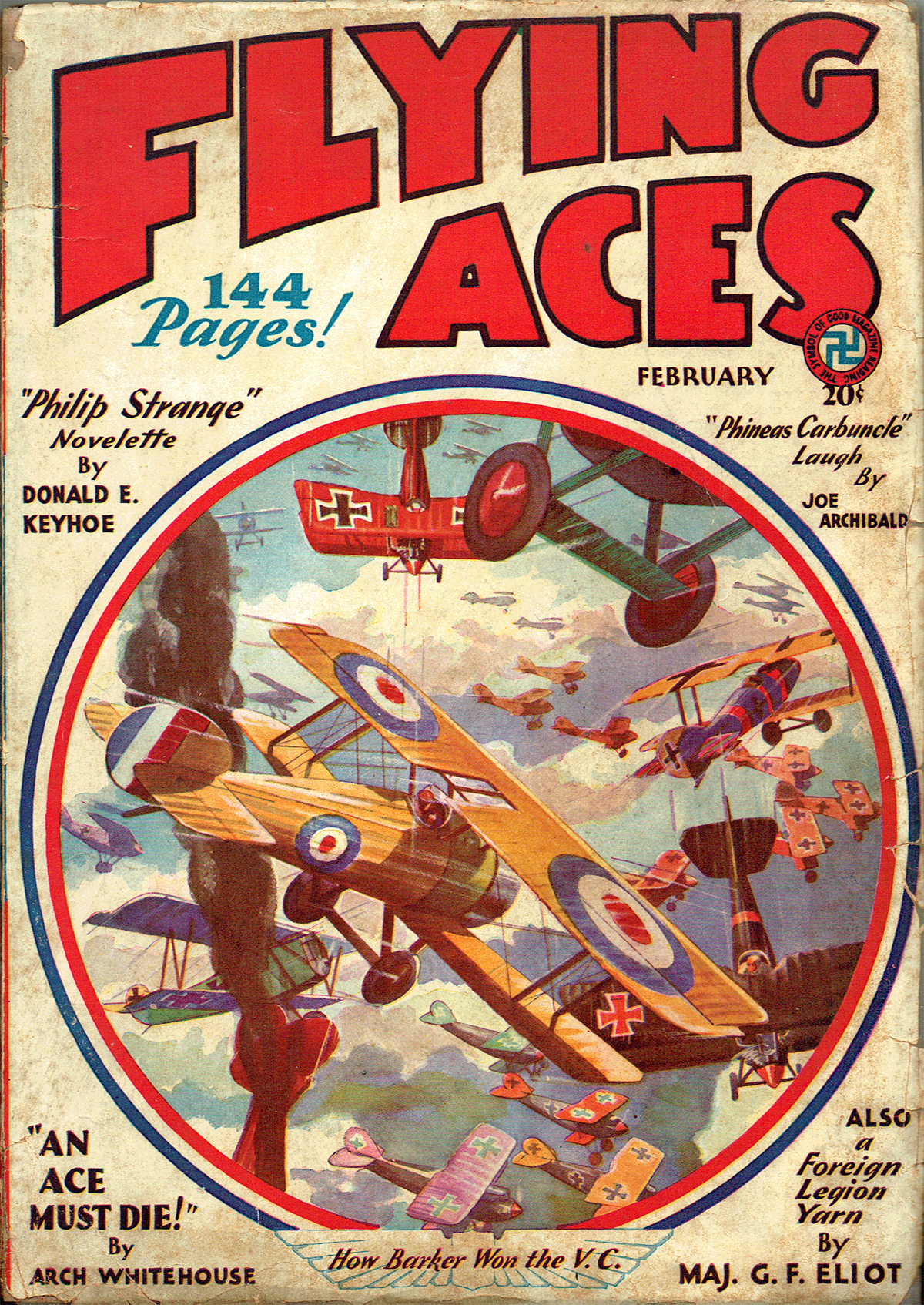 That sound can only mean one thing—that Bachelor of Artifice, Knight of Calamity and an alumnus of Doctor Merlin’s Camelot College for Conjurors is back to vex not only the Germans, but the Americans—the Ninth Pursuit Squadron in particular—as well. Yes it’s the marvel from Boonetown, Iowa himself—Lieutenant Phineas Pinkham!
That sound can only mean one thing—that Bachelor of Artifice, Knight of Calamity and an alumnus of Doctor Merlin’s Camelot College for Conjurors is back to vex not only the Germans, but the Americans—the Ninth Pursuit Squadron in particular—as well. Yes it’s the marvel from Boonetown, Iowa himself—Lieutenant Phineas Pinkham! 




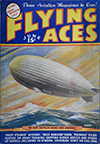

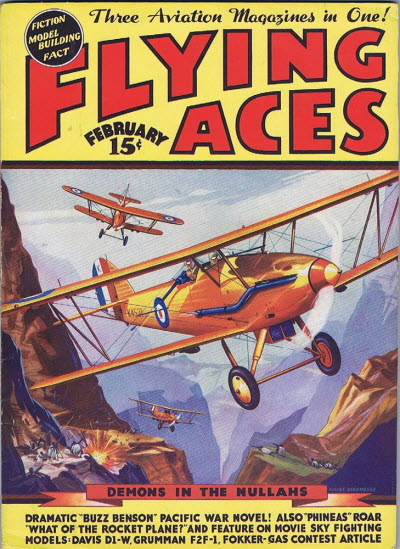 a story by Orlando Rigoni. Rigoni was a very prolific author of western and flying stories appearing in such magazines as Battle Birds, Dare-Devil Aces, Sky Birds, War Birds, Fighting Aces, Sky Fighters, Western Aces, Real Western Round-Up, Thrilling Sports, Air Trails, Western Romances, The Lone Eagle and Flying Acesamong others from roughly 1934 to 1948. He went on to have his stories appear in the slicks; wrote radio and movie scripts; write numerous western novels; and gothic romance novels using the pseudonym “Leslie Aimes.”
a story by Orlando Rigoni. Rigoni was a very prolific author of western and flying stories appearing in such magazines as Battle Birds, Dare-Devil Aces, Sky Birds, War Birds, Fighting Aces, Sky Fighters, Western Aces, Real Western Round-Up, Thrilling Sports, Air Trails, Western Romances, The Lone Eagle and Flying Acesamong others from roughly 1934 to 1948. He went on to have his stories appear in the slicks; wrote radio and movie scripts; write numerous western novels; and gothic romance novels using the pseudonym “Leslie Aimes.”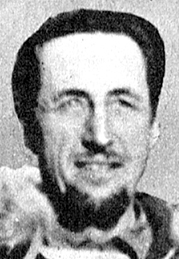 ORLANDO RIGONI, author of “I Want to Know Why” in this issue, appears at the left in a photograph taken in the Yukon last winter while he was working on the Alcan Highway, which, as you doubtless know, is the new road through Canada connecting the United States and Alaska. He is a writer by trade and was working on the road to get material for a novel for young people.
ORLANDO RIGONI, author of “I Want to Know Why” in this issue, appears at the left in a photograph taken in the Yukon last winter while he was working on the Alcan Highway, which, as you doubtless know, is the new road through Canada connecting the United States and Alaska. He is a writer by trade and was working on the road to get material for a novel for young people.



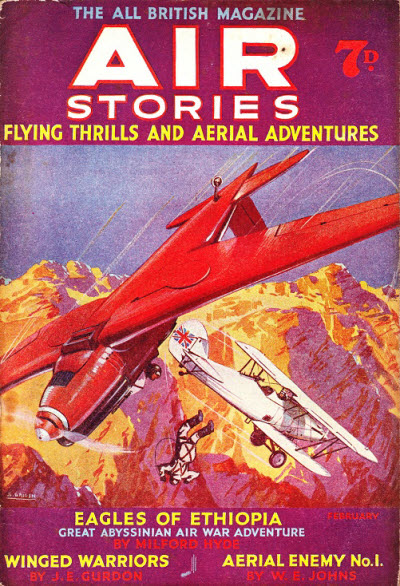 a story from the pen of British Ace,
a story from the pen of British Ace, 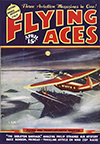

 exciting air adventure with Rusty Wade from the pen of Frank Richardson Pierce. Pierce is probably best remembered for his prolific career in the Western Pulps. Writing under his own name as well as two pen names—Erle Stanly Pierce and Seth Ranger. Pierce’s career spanned fifty years and produced over 1,500 short stories, with over a thousand of these appearing in the pages of Argosy and the Saturday Evening Post.
exciting air adventure with Rusty Wade from the pen of Frank Richardson Pierce. Pierce is probably best remembered for his prolific career in the Western Pulps. Writing under his own name as well as two pen names—Erle Stanly Pierce and Seth Ranger. Pierce’s career spanned fifty years and produced over 1,500 short stories, with over a thousand of these appearing in the pages of Argosy and the Saturday Evening Post. 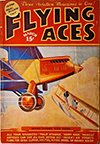
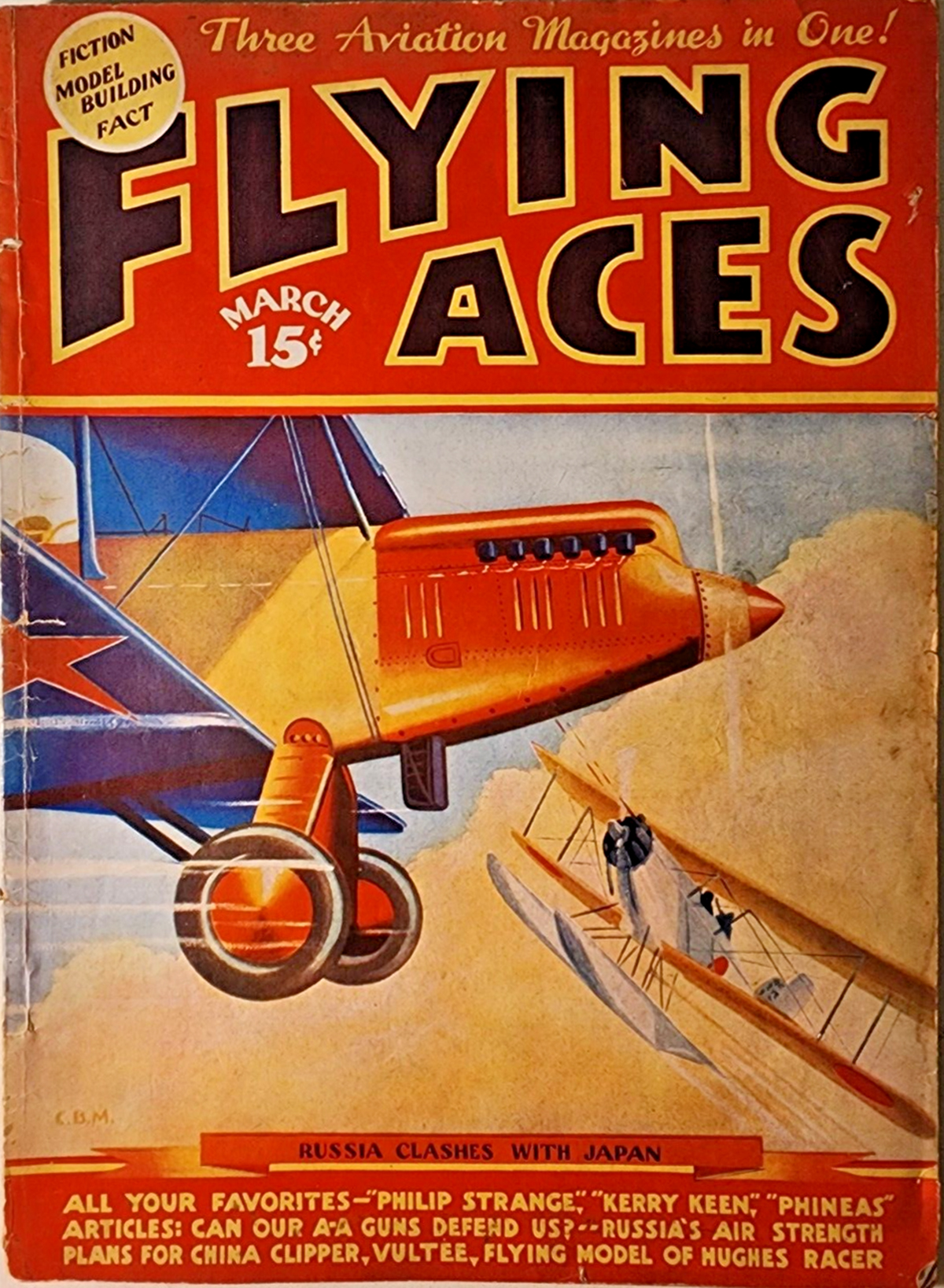
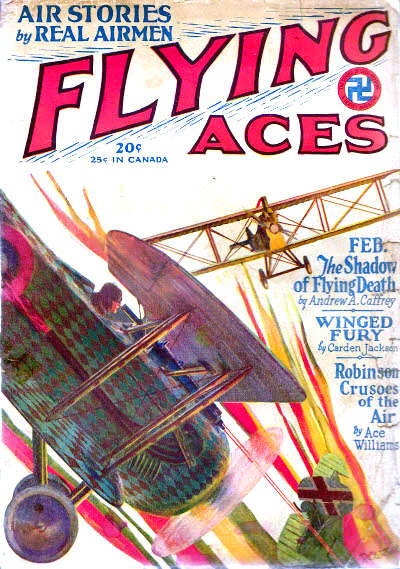 another story by Franklin M. Ritchie. Ritchie only wrote aviation yarns and his entire output—roughly three dozen stories—was between 1927 and 1930. Today we have another one from the lawyer who wrote pulp stories on the side to satisfy his yen for flying. From an early issue of Flying Aces, Ritchie gives us a tale of bomber Jim Barker who longed to show everyone that even a bombing pilot can get Germany’s most ruthless Ace, by any means necessary! From the February 1929 issue of Flying Aces, it’s Franklin M. Ritchie’s “Say It With Bombs!”
another story by Franklin M. Ritchie. Ritchie only wrote aviation yarns and his entire output—roughly three dozen stories—was between 1927 and 1930. Today we have another one from the lawyer who wrote pulp stories on the side to satisfy his yen for flying. From an early issue of Flying Aces, Ritchie gives us a tale of bomber Jim Barker who longed to show everyone that even a bombing pilot can get Germany’s most ruthless Ace, by any means necessary! From the February 1929 issue of Flying Aces, it’s Franklin M. Ritchie’s “Say It With Bombs!”